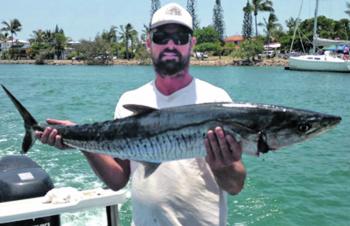South East Queensland is in full swing with spotted and Spanish mackerel from Cape Moreton to Double Island and beyond. Bait schools are plentiful and keeping these speedsters very active. We are currently seeing a lot of Spaniards caught and weighing in around 5-10kg. The average school-sized spotties is around 3-5kg. The season will only improve over the next month or two and we should see the Spanish at a much larger 15-20kg and above.
With mackerel fishing especially, the rule is find the bait, find the fish. Mackerel can often be seen slicing and slashing their way through bait, pushing the school to the surface resulting in a feeding frenzy. A slow trolled dead or live bait presented in this zone will result in a hook-up. Cast a 20-30g chrome or metal slug over the school, wait 8-10 seconds and then retrieve at high speed. If at first you don’t succeed, try again!
I like to find out what they are feeding on. You can generally get a brief glimpse at the type and size of bait the mackerel are feeding on, then match the catch. Select a lure or slug that best replicates the bait for an increased chance of hook-up. The tackle stores across the coast are stocked with all different shapes and sizes, so grab a mixture and find out what works best for you.
You can’t go past a good old deep diving bibbed hardbodied minnow for a mackerel bite. I like something around the 150mm mark trolled at 7-10 knots. We are spoilt for choice with the amount of quality lures available and I stick to something that resembles a slimy mackerel or yakka.
If mackerel fishing isn’t your cup of tea then maybe a mahimahi, wahoo, marlin, cobia or a variety of tuna tickles your fancy. Hutchies, Caloundra Wide and the Barwon Banks are all home to the above species right now. I love summer, because you never know what is going to hit your spread of lures. The sound of a screaming reel is music to anglers’ ears. There are still plenty of tuskies, hussar, pearl perch, trout and a variety of the emperor family on offer across our vast reef systems.
The many wrecks around the coast are still home to XOS kingfish, cobia, cod, snapper and pearl perch. Just last week, I drove over a wreck off Caloundra Wide and the sounder was alight with bait. I dropped a live bait to the depths and before it hit the bottom, I was bent over the gunnels and connected to a 15kg yellowtail kingfish which was filleted later that afternoon.
The estuaries have slowed down a little but locals are still managing to rustle up a feed of quality whiting around the 600g mark and bream in and around the Pumicestone Passage. Flicking soft plastics and surface poppers in the earlier or later parts of the day will see you bag half a dozen good quality specimens. Flathead can’t resist something skipping along the surface. Nor can bream, so you’ll never know unless you have a go.
Around the military jetty and Pelican Waters Bridge Entrance are two cracking spots to fish, because almost anything could take a bait or lure at any time. The Caloundra Bar is forever changing with tidal and current flows landscaping the sea floor. Use a good pair of polarised glasses to pick out the deeper sections and present your offering. Be on the lookout for current lines, eddies and backwash areas. These are areas where the bigger fish will be hanging out.
The Currimundi Lake is another good option this month for a bream or whiting. Again, fish dusk or dawn for a greater chance of hook-up. Overall, February is a great month for offshore fishing, but a little slower for our rivers and lakes. Stay safe and connected.
Reads: 1082
Kyle with a cobia caught at the Caloundra 12 Mile Reef.

Andrew with a Spanish mackerel caught from Caloundra 12 Mile.

There have been a lot of Spaniards around 5-10kg available recently.




